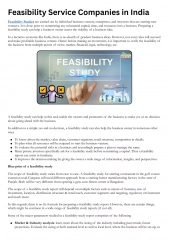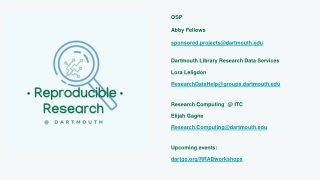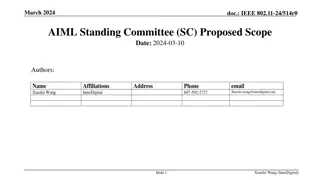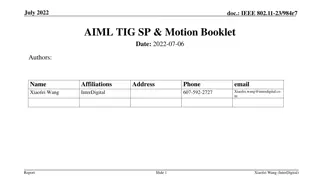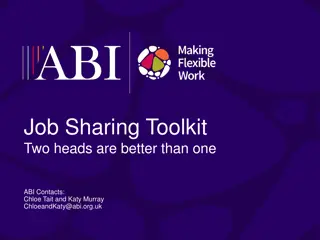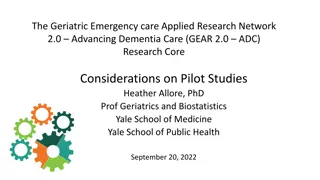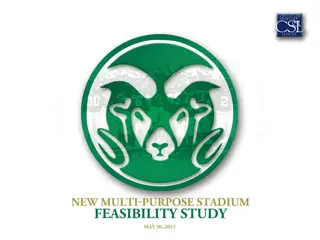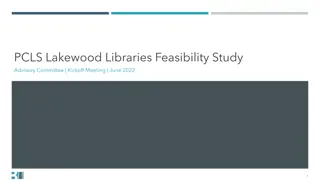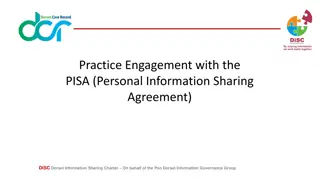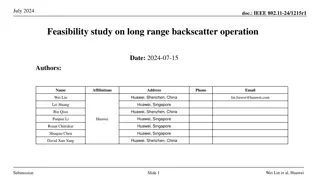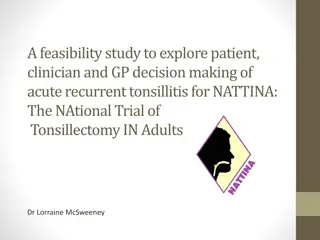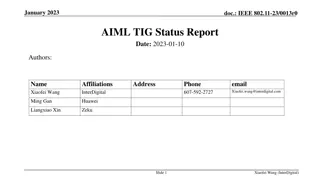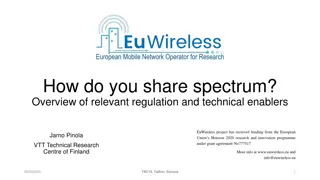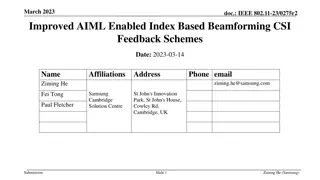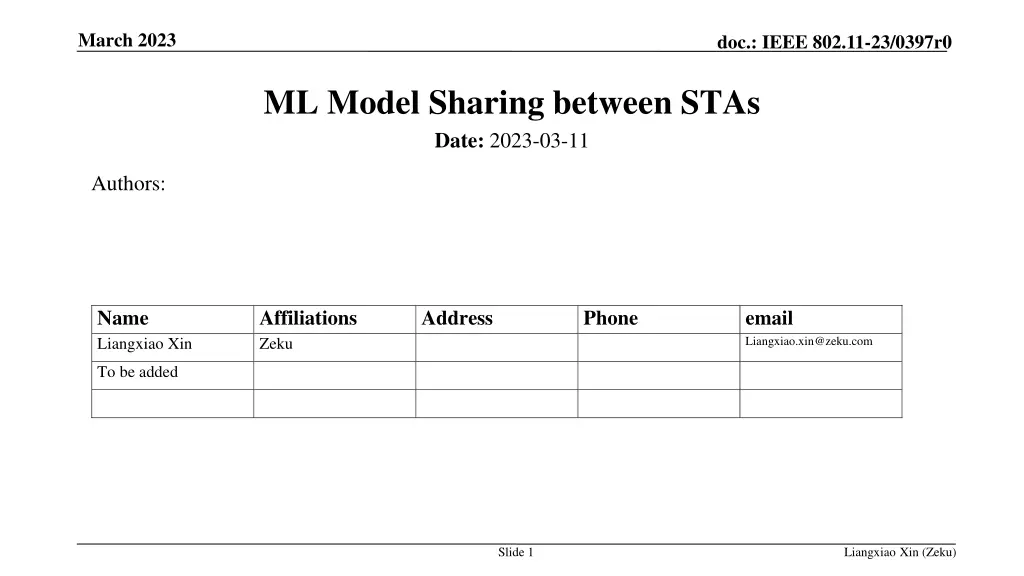
AI/ML Model Sharing Feasibility and Challenges in IEEE 802.11-23
Explore the technical feasibility of sharing AI/ML models between STAs in the context of IEEE 802.11-23. Discuss components of ML models, use cases like Autoencoder for CSI compression, and challenges faced in sharing ML algorithms. Learn how to distribute and share AI/ML models effectively for enhanced collaboration and innovation in the field.
Download Presentation

Please find below an Image/Link to download the presentation.
The content on the website is provided AS IS for your information and personal use only. It may not be sold, licensed, or shared on other websites without obtaining consent from the author. If you encounter any issues during the download, it is possible that the publisher has removed the file from their server.
You are allowed to download the files provided on this website for personal or commercial use, subject to the condition that they are used lawfully. All files are the property of their respective owners.
The content on the website is provided AS IS for your information and personal use only. It may not be sold, licensed, or shared on other websites without obtaining consent from the author.
E N D
Presentation Transcript
March 2023 doc.: IEEE 802.11-23/0397r0 ML Model Sharing between STAs Date: 2023-03-11 Authors: Name Liangxiao Xin Affiliations Zeku Address Phone email Liangxiao.xin@zeku.com To be added Slide 1 Liangxiao Xin (Zeku)
March 2023 doc.: IEEE 802.11-23/0397r0 Abstract In this contribution, we discuss the technical feasibility of AIML model sharing between STAs. Slide 2 Liangxiao Xin (Zeku)
March 2023 doc.: IEEE 802.11-23/0397r0 Introduction One task of AIML TIG is to investigate the technical feasibility of features enabling support of AI/ML [1]. In order to enable support of AI/ML, we need to define signaling of AI/ML related information exchange between STAs [2-6], including capability indication, data report to facilitate AI/ML model training, AI/ML model and model parameters distribution/sharing, management information, additional granularity of Ng value AI/ML model sharing seems the most significant standard impact and its technical feasibility needs to be well discussed. In this contribution, we discuss how to distribute/share the AI/ML model or AI/ML model parameters between STAs. Slide 3 Liangxiao Xin (Zeku)
March 2023 doc.: IEEE 802.11-23/0397r0 Components of ML model We can regard a ML model as a black box, which consists of Algorithm: the algorithm, such as linear regression, deep learning, that the ML model uses to calculate the output by given the input. It can be an executable code. Model parameter: the parameters that are used to configure the algorithm, which are updated by model training Training data: the data is used to train the model and decides the ML model parameters Input and output: the input and output of the ML model algorithm, which are decided by the purpose (use case) of ML model ML algorithm (model parameter) Output Input Training Data Slide 4 Liangxiao Xin (Zeku)
March 2023 doc.: IEEE 802.11-23/0397r0 Use case of ML model sharing Autoencoder Autoencoder is popular ML model for CSI compression input and output are known Assume that the encoder and decoder are trained offline. Encoder and decoder are a pair of ML algorithms that are deployed at STA1 and STA2. Encoded CSI feedback bits Encoder Decoder Recovered CSI feedback Original CSI feedback STA1 STA2 The ML model algorithms and model parameters between STAs have to be shared. Slide 5 Liangxiao Xin (Zeku)
March 2023 doc.: IEEE 802.11-23/0397r0 Challenges of sharing ML algorithm It is difficult to pre-install the same AIML algorithm on the two devices It is difficult to have one or several universal ML models used by all devices even for a same use case. Each company has its own team to develop ML model and may prefer to keep the model secret. Machine learning is a popular topic and the improvement of ML model happens frequently. Then, it requires one device to share its ML algorithm with other device to enable the ML functionality. Proposal 1: transmit the ML algorithm over the air Proposal 2: download the algorithm from verified server We are going to discuss the above two proposals. Slide 6 Liangxiao Xin (Zeku)
March 2023 doc.: IEEE 802.11-23/0397r0 Proposal 1: transmit ML algorithm over-the-air Advantage: ML model can be shared within IEEE 802.11 network. Difficulties: How to execute ML algorithm received from the frame? Compatibility issue: the ML algorithm may not be able to execute at firmware Security issue: the ML algorithm may include backdoors which may cause security issue STA1 STA2 Frame (ML model) Install ML model from frame Frame (Input of ML model) Run ML model Frame (Output of ML model) Slide 7 Liangxiao Xin (Zeku)
March 2023 doc.: IEEE 802.11-23/0397r0 Proposal 2: download the algorithm from verified server Advantage: Cloud server can stores a large amount of ML algorithms and updates the ML algorithms frequently. Cloud server can verify the ML algorithms to ensure the security of those ML algorithms. Difficulties: Interaction with a cloud server for ML algorithms may be out of scope of IEEE 802.11 Cloud server requires additional cost and it is not clear who should be responsible to maintain the cloud server. STA1 STA2 Frame (ML model ID) Install ML model from server Cloud Server Frame (Input of ML model) Run ML model Frame (Output of ML model) Slide 8 Liangxiao Xin (Zeku)
March 2023 doc.: IEEE 802.11-23/0397r0 Summary ML model sharing requires to share the model algorithm between STAs We discussed several proposals to share ML algorithms between STAs. Proposal 1: share ML model by sending frames over the air Proposal 2: share ML model by downloading model from a cloud server Each proposal has difficulties that we need to solve in the future. Slide 9 Liangxiao Xin (Zeku)
March 2023 doc.: IEEE 802.11-23/0397r0 References [1]11-22/0597r3 May 2022 Working Group Motions, May 18, 2022 [2] 11-22/1934r5 Proposed IEEE 802.11 AIML TIG Technical Report Text for the CSI Compression Use Case [3] 11-23/0050r3 Proposed Technical Report Text for AIML Model Sharing Use case [4] 11-22/2119r5 Proposed IEEE 802.11 AIML TIG Technical Report Text for the Distributed Channel Access Use Case [5] 11-23/0227r1 Proposed IEEE 802.11 AIML TIG Technical Report Text for the Multi-AP Coordination Use Case [6] 11-23/0217r0 Proposed IEEE 802.11 AIML TIG Technical Report Text for the Subcarrier Grouping Use Case Slide 10 Liangxiao Xin (Zeku)

